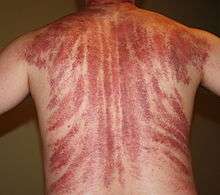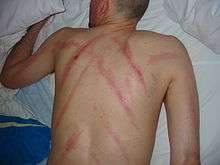Gua sha

| Gua sha | |||||||||||||||||
|
"Gua sha" in Chinese characters | |||||||||||||||||
| Chinese | 刮痧 | ||||||||||||||||
|---|---|---|---|---|---|---|---|---|---|---|---|---|---|---|---|---|---|
| Literal meaning | "scraping sha-bruises" | ||||||||||||||||
| |||||||||||||||||
| This article is part of a series on |
| Fringe medicine and medical conspiracy theories |
|---|
 |
|
General information |
|
Gua sha (Chinese: 刮痧) is a traditional Chinese medical treatment in which the skin is scraped to produce light petechiae. Practitioners believe that gua sha releases unhealthy bodily matter from blood stasis within sore, tired, stiff or injured muscle areas to stimulate new oxygenated blood flow to the areas, thus promoting metabolic cell repair, regeneration, healing and recovery. Gua sha is sometimes referred to as "scraping", "spooning" or "coining" by English speakers. The treatment has also been called the descriptive French name, tribo-effleurage.[1]
Gua sha should not be confused with ZhenBian (Chinese: 针砭) which looks similar but is a different procedure.([2]).
Gua sha was transferred to Vietnam from China as cạo gió, and is very popular in Vietnam. This term translates roughly "to scrape wind," as in Vietnamese culture "catching a cold" or fever is often referred to as trúng gió, "to catch wind." The origin of this term is the Shang Han Lun, a c. 220 CE Chinese Medical text on cold induced disease--like most Asian countries, China's medical sciences was a profound influence in Vietnam, especially between the 5th and 7th Centuries CE.[3] Cạo gió is an extremely common remedy in Vietnam and for expatriate Vietnamese.
Gua sha is also used in Indonesia; in Java it is known as kerikan (lit., "scraping technique") or kerokan, and is very widely used--as a form of folk medicine--upon members of individual households.
Technique

Gua sha involves repeated pressed strokes over lubricated skin with a smooth edged and blunt instrument. Skin is typically lubricated with massage oil or balm, and commonly a ceramic Chinese soup spoon was used, or a blunt well worn coin, even honed animal bones, water buffalo horn, or jade, or even a simple metal cap with a blunt rounded edge is used.
In cases of fatigue from heavy manual labor work, a piece of ginger root soaked in rice wine is sometimes used to rub down the spine from top to bottom.
The smooth edge is placed against the oiled skin surface, pressed down firmly, and then moved down the muscles—hence the term tribo-effleurage (i.e., friction-stroking)—or along the pathway of the acupuncture meridians, along the surface of the skin, with each stroke being about 4–6 inches long.
Practitioners tend to follow the tradition they were taught to obtain sha: typically using either gua sha or fire cupping. The techniques are sometimes used together.[4] In China, they are widely available from national and public hospitals to private massage shops, because of local people's deep trust to TCM (Traditional Chinese Medicine) and reasonable price, they are very popular.
Cross-cultural confusion with physical abuse
A slightly different form of gua sha using the edges of coins rather than porcelain items is practiced as a folk medicine technique. Individuals practice this "coining" amongst their own family members in many Asian countries, such as in Vietnam (where the coin scraping, or "coining" is known as "cạo gió", 'scraping for wind'), or in Cambodia, and also in their respective emigrant communities abroad. Health care practitioners in hospitals in Orange County, California, routinely see evidence of coining among hospitalized Vietnamese patients.
In 1980, it was found that many Vietnamese still distrusted U.S. medical practitioners in part due to fear of being accused of child abuse.
"This practice has been misidentified as child abuse in case reports," despite the intention of the parents.[5] However, physicians are required by law to report injuries from remedies such as "coining" to the appropriate agency (e.g., state child-protective service or state adult-protective service), regardless of intention.[6]
Lack of evidence-based practice and safety concerns
The effectiveness of gua sha is not supported by conclusive research, studies have compared it to acupuncture & sham trial, however these have been of poor quality and further study is needed.[7] Some studies have found that gua sha has beneficial short-term relief effects in patients with stiff muscles and chronic muscular pain,[8][9] but further study is needed.
The use of safety standards and proper protocols is taught in acupuncture schools across the country. However, there was a case report of acute epiglottitis due to gua sha treatment on the neck for throat pain.[10] The continuously applied pressure from gua sha could have damaged the underlying soft tissue, resulting in acute swelling and difficulty breathing.[10] Furthermore, the use of gua-sha along other CAMs was associated with a lower quality of life in patients with rhinitis.[11]
The use of hospital standards of sterilization and personal protective equipment is important to prevent contamination of infectious pathogens.[12] Although no cases of blood-borne pathogens have been reported, the risk of transmission of blood cells and fluids cannot be ruled out. Protective measurements against infectious agents that are recommended include the single use of disposable devices, sterilization of re-used equipment and glove use.[12] Lubricants should be poured out into cups and they are to be disposed after each use.[12] Devices that cannot be adequately sterilized such as horn and bone are not recommended.[12]
In popular culture
The 2001 movie The Gua Sha Treatment (Chinese: 刮痧; pinyin: guā shā) was made in Hong Kong showing gua sha among other things. The movie starred Tony Leung Ka-Fai, Jiang Wenli, and Zhu Xu. It can also be seen in the 1995 Vietnamese movie Cyclo.
See also
Notes
- ↑ Huard & Wong (1977), p.126. Also cited is a French romanization for the same set of two Chinese characters: koua sha.
- ↑ http://hanyu.baidu.com/zici/s?wd=%E9%92%88%E7%A0%AD&query=%E9%92%88%E7%A0%AD&srcid=28232&from=kg0&from=kg0
- ↑ Needham, J., Celestial Lancets, Cambridge, UK: Cambridge University .
- ↑ One of the first to introduce the technique of gua sha to non-Chinese students in the United States was James Tin Yau So (1911 - ).
- ↑ http://childabuse.stanford.edu/faq.html
- ↑ Fadem, Barbara (2009). Behavioral Science - Board Review Series. Baltimore, MD: Lippincott Williams & Wilkins. p. 206. ISBN 978-0-7817-8257-9.
- ↑ Lee MS, Choi TY, Kim JI, Choi SM (2010). "Using Guasha to treat musculoskeletal pain: a systematic review of controlled clinical trials". Chin Med. 5: 5. doi:10.1186/1749-8546-5-5. PMC 2827462. PMID 20205902.
- ↑ Braun M; Schwickert M; Nielsen A; Brunnhuber S; Dobos G; Musial F; et al. (2011). "Effectiveness of traditional Chinese "gua sha" therapy in patients with chronic neck pain: a randomized controlled trial". Pain Med. 12 (3): 362–9. doi:10.1111/j.1526-4637.2011.01053.x. PMID 21276190.
- ↑ Lauche R; Wübbeling K; Lüdtke R; Cramer H; Choi KE; Rampp T; et al. (2012). "Randomized controlled pilot study: pain intensity and pressure pain thresholds in patients with neck and low back pain before and after traditional East Asian "gua sha" therapy". Am J Chin Med. 40 (5): 905–17. doi:10.1142/S0192415X1250067X. PMID 22928824.
- 1 2 Tsai, Keng-Kuang, and Chih-Hung Wang. (2014) "Acute Epiglottitis following Traditional Chinese Gua Sha Therapy." CMAJ 186.8
- ↑ Koo, Malcolm; Liang, Kai-Li; Jiang, Rong-San; Tsao, Hsin; Yeh, Yueh-Chiao (2014-01-01). "Association between Disease-Specific Quality of Life and Complementary Medicine Use in Patients with Rhinitis in Taiwan: A Cross-Sectional Survey Study". Evidence-based Complementary and Alternative Medicine : eCAM. 2014. doi:10.1155/2014/958524. ISSN 1741-427X. PMC 4228815. PMID 25530792.
- 1 2 3 4 Nielsen, Arya, Ben Kligler, and Brian S. Koll. "Safety Protocols for Gua Sha (press-stroking) and Baguan (cupping)." Complementary Therapies in Medicine 20.5 (2012): 340-44.
References
- Huard, P. & Wong, M. (Smith, D.N. trans.), Oriental Methods of Mental and Physical Fitness: The Complete Book of Meditation, Kinesitherapy, and Martial Arts in China, India, and Japan, Funk & Wagnalls, (New York), 1977. ISBN 0-308-10271-1
- Nielsen, A., Gua Sha: Traditional Technique for Modern Practice, Churchill Livingstone, (Edinburgh/New York), 1995. ISBN 0-443-05181-X
- Nielsen, A., "Gua Sha. Step-by-Step: A Visual Guide to a Traditional Technique for Modern Medicine" (teaching video)Verlag fuer Ganzheitliche Medizin, Koetzing, Germany. 2002. ISBN 3-927344-63-X
- Yeatman, GW; Dang, VV (1980). "Cao gio (coin rubbing): Vietnamese attitudes toward health care". JAMA. 244: 2748–2749. doi:10.1001/jama.244.24.2748.